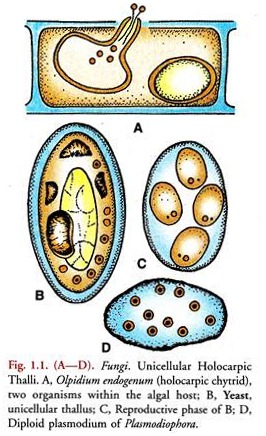The following points highlight the two main types of thallus found in fungi with their diagrams. The types are: 1. Unicellular Thallus 2. Filamentous Thallus.
Type # 1. Unicellular Thallus (Fig. 1.1):
In some of the lower fungi such as the chytrids, the thallus is more or less a spherical, single-celled structure (A). At the time of reproduction, it becomes a reproductive unit. The latter produces the asexual or sexual cells. Such fungi are called holocarpic. In them, the vegetative and reproductive stages do not occur together in the same thallus.
Plasmodiophora has a vegetative phase consisting of a naked, multi-nucleate, amoeboid mass of protoplasm (D). It is termed Plasmodium. The protoplast of the diploid Plasmodium cleaves to form the resting spores. The yeasts, which are related to the filamentous forms, also have a unicellular thallus (B). In the unicellular holocarpic forms (Synchytrium, Fig. 4-4D), the mycelium is absent.
Type # 2. Filamentous Thallus (Fig. 1.2):
The vast majority of the fungi have a filamentous thallus. It originates through the germination of a spore. The spore germinates as it lands on a suitable substratum where other conditions of life are also favourable. In some species, the spore, on germination, produces only a short, tubular structure of limited growth.
It constitutes the thallus and is technically called a hypha. The spores of most of the fungi, however, give rise to a fluffy thallus consisting of a cottony mass of fine, branched filaments. These long, fine filaments are called the hyphae (sing, hypha). Some of these hyphae, at a certain stage of maturity, extend into the air and bear the reproductive bodies.
The rest spread over or within the substratum and continue the normal activities. Such fungi are called eucarpic. Collectively the hyphae comprise the vegetative body (thallus) of a fungus which is called the mycelium. The hypha is thus a structural unit of the mycelium. It consists of a thin, transparent wall filled or lined with a layer of cytoplasm.
The medium upon which the mycelium grows is known as substratum. The mycelium is the food procuring structure in the life cycle. It carries on the general activities of a plant cell such as absorption, digestion, respiration, excretion and growth but not photosynthesis. The hyphae constituting the mycelium branch, spread in all directions within or over the substratum to form a loose and ramifying network.
The hyphae are usually colourless particularly those embedded in the substratum. The aerial hyphae in some fungi become coloured. Black, orange, yellow, red, blue and brown are the usual tints. The colour is usually confined to the hyphal wall.
Even when the pigments are present in the protoplasmic contents, they do not form an integral part of the living matter. The pigments play no role in the physiology of the fungus. The growth in length takes place at the tips of the hyphae and is thus termed apical.

